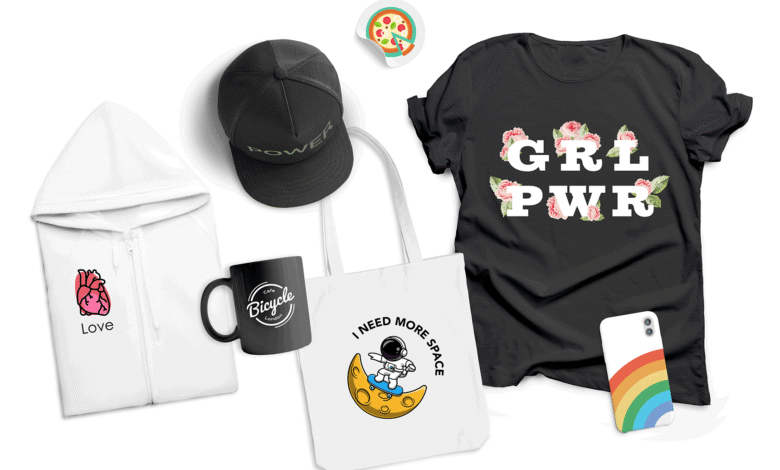How to Make and Sell Merch For Your Brand in 2025

Discovering additional sources of income can be quite helpful when managing a small business or starting a company.
After all, developing a brand isn’t always inexpensive, so you should embrace any opportunity to make more money.
High-quality merchandise can help you achieve that very goal! Here, I’ll walk you through creating and selling merchandise for your brand in 2025 so you can grow your company and earn extra money.
Short on time? Here are the key takeaways
- Step 1: Create a brand identity: Determine your brand’s popularity first, then how your merchandise may reflect that..
- Step 2: Recognize your audience: Next, as this will influence marketing campaigns and designs, learn about the characteristics and purchasing patterns of your target demographic.
- Step 3: Deciding what to sell: Choose products that fulfill audience expectations and have a healthy profit margin.
- Step 4: Design style: Once chosen, get to work creating the look you want for your products.
- Step 5: Test and learn: Obtain samples of your initial design attempts and solicit input from loved ones.
- Step 6: Select a manufacturer: After you’re satisfied with them, plan production and begin storing your merchandise so it’s ready to sell.
Firstly, What is Merch?
Before we jump straight in, I wanted to quickly touch on what I mean by the term merch. Merch is a common abbreviation for merchandise, and you’ll likely hear influencers, YouTubers, and streamers refer to it as one of their main sources of income.
In simple terms, the phrase ‘merch’ refers to any products that are branded in line with a company or popular personality and sold to fans of that business or person.
While it has often been popular with social media celebrities, it has become a more and more popular option for more mainstream businesses as well, most notably coffee shops, bookstores, or other locally run businesses.
Why is merch so popular?
Customers choose to buy a brand’s items for a number of factors; therefore, it’s not simply one of the main ones that contribute to its success.
One of the primary reasons is that it gives customers a better understanding of the inner workings of the company and is a fantastic method to demonstrate support and devotion to that brand.
People recognize that managing a small business may be difficult, which is why merch is so popular with local businesses in the area. They buy merch as a token of appreciation.
It also has sentimental value because it can be viewed as a keepsake of a special occasion, like a t-shirt from your favorite band’s performance. I can speak from experience because I have a number of Sam Fender t-shirts that satisfy this need, as well as one from a coffee shop that I have many happy memories of, but that closed its doors in 2020.
Additionally, it enables clients to express their personalities in addition to their assistance. Buying merchandise from their favorite brands is a great method for people to express their identity and preferences through their wardrobe choices.
Establishing a profitable retail store can be really successful, as you can guess. As a result, a lot of influencers and businesses are also trying to enter the merch industry. If you don’t make the kind of things that your audience wants to see, you’ll have trouble breaking into the market.
Your 6-Step Plan to Selling Merchandise Successfully
In light of all of that, here is a very short six-step procedure that you may use to begin selling merchandise profitably.
1. Build a brand identity
Make sure you have an audience that will be interested in what you have to offer before investing a lot of money in your merch adventure.
Even if your clients may be satisfied with your IT solutions, that doesn’t guarantee they want your logo emblazoned on their mugs and tote bags.
Therefore, you must first make sure that your brand identity is distinct and captivating. But that’s more than simply a striking logo. It’s also what people think about when they see your branding and the image and personality that are associated with it.
Cool content creators, well-known influencers, and hip coffee shops are some of the most prosperous merchandise retailers. This is due to the fact that merchandise for these brands enables consumers to flaunt their brand loyalty while also conveying to others that they are cool since they are followers of those brands and figures.
This is a brief guide on building a genuine, high-quality brand.
- Define your basic beliefs: Determine the guiding principles of your brand and make sure they complement your objective and the expectations of your target audience. Adhering to these principles in every facet of your company is what makes you authentic.
- Recognize your audience: Recognize the wants, needs, and problems of your target market. Communicate in their language and provide material that speaks to them more deeply.
- Create a distinctive brand voice: Create a unique message style and tone that captures the essence of your brand. Voice consistency fosters recognition and trust.
- Create a distinctive visual identity: Your font, colors, and logo should convey the spirit of your company and leave a lasting impression. Brand identity is strengthened by cohesive images.
- Describe a gripping tale: Communicate the history, mission, and development of your brand in a way that emotionally engages your target audience. Consumers are more likely to interact with brands that seem relatable and human.
- Maintain uniformity on all platforms: Keep your website, social media accounts, and packaging consistent in terms of appearance, tone, and user experience. Consistency fosters recognition and trust.
- Participate and pay attention to your neighborhood: Encourage deep conversations by answering questions, getting input, and expressing gratitude. Brand loyalty is strengthened by a vibrant community.
- Fulfill your commitment: Reliability and quality are essential for creating a genuine brand. Make sure the messaging of your brand is reflected in your goods, services, and client interactions.
- Display actual people and their experiences: Emphasize client endorsements, behind-the-scenes material, and practical brand uses. Transparency serves to reinforce authenticity.
2. Know your audience
It’s time to learn more about your audience after you’ve perfected your branding. Selecting the right things to sell will be made much easier if you have a thorough understanding of the needs, desires, and behavior of your audience.
Gathering this information should be rather easy if you already have a following of devoted clients. You may do this by looking via social media engagements, reviews, and feedback.
If you don’t yet have a sizable dataset, you can compile all of the data you currently have on your current audience and use ChatGPT to extract further insights and build upon the scant knowledge you do have.
One excellent method to eliminate uncertainty in product selection is to conduct surveys or solicit feedback on social media posts, provided that you have the requisite audience size.
If not, examine your present clientele, find out what else they like and detest about your sector, and observe what those rivals appear to be selling and how successful they are at it.
3. Choosing what to sell
The next step is to compile your product ideas and decide what you wish to market. Costs, profit margins, and availability must all be taken into consideration, even if the majority of the data you utilize for this will be determined by audience preference.
Here is a brief summary of some of the most widely used options that many companies and people choose:
- Hats
- T-shirts
- Mugs
- Phone cases
- Hoodies
- Sweatshirts
- Tote bags
4. Design time
This is possibly the most difficult step, since if the designs are poor, it doesn’t matter what merchandise you have planned! Use only the best images and graphics and rely heavily on your brand colors to create designs that you know will appeal to your target audience.
I advise brands to keep things as simple as possible, emphasizing designs that are easy to recognize and fonts that are clear and easy to read.
5. Test and learn
It can be very tempting to rush to get your products to market as soon as you’re satisfied with your designs, but this is one of the worst blunders you can make.
What if, after all, you committed a terrible spelling mistake? Your “getting your ducks in a row” skills may suddenly become less kid-friendly!
Talk to friends and relatives for frank feedback on your efforts to avoid such costly issues. Since buying stock is not inexpensive, you should pick people you can trust to tell you what they truly think.
Feedback offers you the confidence you need to sell your things online and is the best approach to determine what is likely to work and what isn’t.
6. Choose a manufacturer
It’s time to make your merchandise ideas a reality after you’ve received your candid criticism, eaten your pride, and made any required adjustments.
You can either use a manufacturer or print on demand when it comes to creating and stocking your merchandise.
Since each offers advantages of its own, it’s critical to conduct as thorough a study as you can on both. Anyone who is uncertain about how well their merchandise will be accepted might benefit greatly from print-on-demand since it keeps prices down and eliminates inventory issues.
Since buying in bulk is frequently far less expensive than a print-on-demand option, you might wish to choose a manufacturer if you are certain that your merchandise will sell out soon.
READ MORE: LAD REPORTING




